- Why Insulating Your Compost Heap is Important
- Benefits of Keeping Worms Active During Winter
- Preventing Freezing in Your Compost Heap
- 1. Insulate your compost heap
- 2. Use a compost thermometer
- 3. Keep the pile moist
- 4. Consider using a compost bin
- 5. Avoid turning the pile too frequently
- 6. Consider adding heat sources
- Choosing the Right Insulation Materials
- 1. Organic Materials
- 2. Natural Fabrics
- 3. Recycled Materials
- 4. Bubble Wrap
- 5. Insulation Blankets
- 6. Foam Panels
- 7. Reflective Materials
- 8. Combination of Materials
- How to Layer and Cover Your Compost Heap
- 1. Start with a Base Layer
- 2. Add Layers of Organic Matter
- 3. Keep the Layers Moist
- 4. Cover the Heap
- 5. Monitor and Turn the Heap
- Maintaining Proper Moisture Levels
- Monitoring and Troubleshooting Your Insulated Compost Heap
- Monitoring
- Troubleshooting
- Harvesting the Rich Compost in Spring
- “Question-Answer”
- How can I prevent my compost heap from freezing in winter?
- What are some materials I can use to insulate my compost heap?
- Do I need to add a lot of insulation to my compost heap?
- Can I still add kitchen scraps to my compost heap in winter?
- Will insulating my compost heap help to keep the worms active?
- Can I use a tarp to cover my compost heap for insulation?
- “Video” How to Fix Composting Problems: Smelly, Slimy or Slow Compost Bins
As winter approaches, it’s important to take the necessary steps to protect your compost heap and keep it active and healthy. One of the key challenges during winter is keeping the worms in your compost happy and active, as they play a vital role in the decomposition process. In this article, we will explore some effective methods to insulate your compost heap and prevent freezing, ensuring a constant supply of rich, nutrient-dense compost for your garden.
1. Adding a layer of straw or hay: One of the simplest and most effective ways to insulate your compost heap is to add a layer of straw or hay. This acts as a protective barrier, trapping heat and preventing freezing. It also helps retain moisture and provides an additional food source for the worms. Simply spread a thick layer of straw or hay over the top of your compost heap, making sure to cover the entire surface.
2. Using a compost blanket: Another option is to use a compost blanket, which is specially designed to provide insulation and protect your compost from extreme temperatures. Compost blankets are made from insulating materials, such as recycled fabrics or fleece, and can be easily placed over your compost heap. They help to maintain a stable temperature within the heap and prevent the worms from becoming too cold.
3. Building a compost bin with insulation: If you have the space and resources, consider building a compost bin with built-in insulation. This can be done using materials such as straw bales, wooden pallets, or even old tires filled with soil. The insulating layer will help regulate the temperature inside the bin, keeping it warm enough for the worms to remain active throughout the winter.
Remember, a healthy and active compost heap during winter means a constant supply of nutrient-rich compost for your garden.
By implementing these insulation methods, you can ensure that your compost heap remains active and productive throughout the colder months. Remember to monitor the moisture levels and occasionally turn the compost to maintain airflow and help with decomposition. A well-insulated compost heap will not only keep your worms happy but also provide you with a bountiful supply of compost to enrich your soil and promote healthy plant growth.
Why Insulating Your Compost Heap is Important
Insulating your compost heap is an essential step in ensuring its success, especially during the winter months. While composting is a natural process, it can be negatively impacted by cold temperatures. Insulation acts as a protective layer, helping to maintain the necessary heat levels and preventing freezing.
1. Maintains optimal temperature:
A compost heap needs a certain temperature range to support the breakdown of organic matter. Insulating materials such as straw, leaves, or old blankets help to retain heat within the compost pile, even in freezing conditions. This insulation prevents the internal temperature from dropping too low, ensuring the composting process continues.
2. Promotes microbial activity:
The decomposition process in a compost heap relies on the activity of microorganisms, worms, and other beneficial creatures. Insulating the compost heap keeps these organisms active and prevents them from becoming dormant due to cold temperatures. Active microbial activity is crucial for the decomposition of organic matter and the production of fertile compost.
3. Reduces moisture loss:
Insulation helps to reduce moisture loss from the compost heap, which can occur when exposed to cold and dry conditions. Moisture is essential for microbial activity and the breakdown of organic matter. By retaining moisture, insulation helps to create the ideal environment for the composting process.
4. Prevents freezing:
During winter, freezing temperatures can completely halt the composting process. An insulated compost heap prevents freezing by maintaining a consistent internal temperature, ensuring that decomposition continues even when temperatures drop outside.
5. Protects beneficial organisms:
An insulated compost heap provides a protective environment for the worms, insects, and other beneficial organisms that contribute to the composting process. By creating a barrier against extreme cold, insulation helps to ensure the survival and activity of these organisms, maintaining a healthy and productive compost pile.
Insulating your compost heap is a simple and effective way to support the composting process throughout the year, especially during the colder months. By maintaining the optimal temperatures, promoting microbial activity, reducing moisture loss, preventing freezing, and protecting beneficial organisms, insulation ensures that your compost heap remains active and productive.
Benefits of Keeping Worms Active During Winter
Keeping worms active during winter in your compost heap can bring numerous benefits:
- Continued decomposition: Worms are essential for breaking down organic materials in the compost heap. Their activity helps to ensure that decomposition process continues during the colder months, making the compost ready for use in spring.
- Enhanced nutrient availability: Worms play a crucial role in transforming organic matter into nutrient-rich humus. By keeping them active during winter, you can ensure that valuable nutrients are made available to your plants when they need them the most in the growing season.
- Improved soil structure: Worms help to improve soil structure by creating burrows and tunnels as they feed on organic matter. Active worms during winter can continue this process, leading to a more well-drained and aerated soil in the spring.
- Natural pest control: Worms also act as natural pest controllers. Their presence in the compost heap can help to control populations of harmful insects, larvae, and eggs, reducing the overall pest pressure in your garden.
- Environmental sustainability: By keeping worms active during winter, you are promoting a more sustainable and environmentally friendly approach to managing organic waste. Worms help to divert food scraps and other organic materials from going to landfills, reducing greenhouse gas emissions and supporting a circular economy.
Overall, keeping worms active during winter is not only beneficial for your compost heap, but also for the health of your soil, plants, and the environment as a whole.
Preventing Freezing in Your Compost Heap
Winter weather can pose a challenge for composters, as freezing temperatures can slow down the decomposition process and make it difficult for worms to survive. However, there are several strategies you can employ to prevent your compost heap from freezing during the winter months.
1. Insulate your compost heap
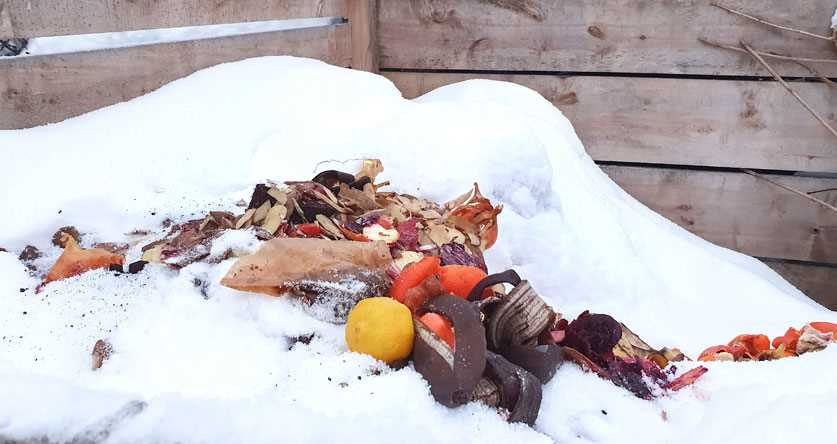
To prevent your compost heap from freezing, it’s important to insulate it properly. Start by layering a thick cover of straw, leaves, or shredded paper on top of your compost pile. This will act as a natural insulator, helping to retain heat in the pile and prevent freezing.
2. Use a compost thermometer
Monitoring the temperature of your compost heap is crucial during the winter months. Invest in a compost thermometer and regularly check the temperature of your pile. If the temperature starts to drop towards freezing, you may need to add more insulation or adjust the moisture content to keep the pile active.
3. Keep the pile moist
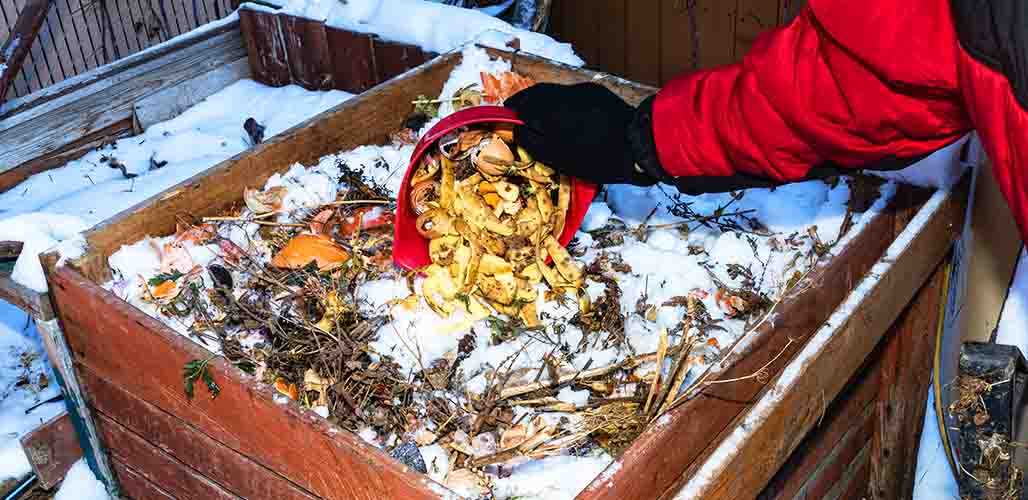
Dry compost piles are more prone to freezing, so it’s important to maintain the right moisture content. Monitor the moisture level of your compost pile and water it if necessary. Aim for a moisture level of around 50%, which should help to keep the pile active and prevent freezing.
4. Consider using a compost bin
If you’re facing extreme winter conditions or simply want extra protection for your compost heap, consider using a compost bin. Compost bins provide additional insulation and can help to keep the pile warmer during the winter months. They also prevent the pile from spreading out too much, which can lead to heat loss.
5. Avoid turning the pile too frequently
While turning your compost pile is important for aeration and decomposition, it’s best to avoid turning it too frequently during the winter months. Turning the pile releases heat and can disrupt the insulation. Instead, focus on maintaining the right moisture level and monitoring the temperature of the pile.
6. Consider adding heat sources
If you’re still concerned about freezing temperatures, you can consider adding heat sources to your compost heap. This could include burying heat-generating materials like manure or using a heating mat designed for composting. However, be cautious when adding heat sources, as they can increase the risk of undesirable smells or attracting pests.
By following these strategies, you can prevent your compost heap from freezing during the winter and keep the worms active. A properly insulated and maintained compost pile will continue to decompose organic matter, even in the coldest months, helping you to create nutrient-rich compost for your garden.
Choosing the Right Insulation Materials
Insulating your compost heap is crucial for keeping the worms active and preventing freezing during the winter months. There are various insulation materials available, but it is important to choose the right ones for optimum results. Here are some factors to consider when selecting insulation materials for your compost heap:
1. Organic Materials
Using organic materials for insulation is not only environmentally friendly but also beneficial for your compost heap. Straw, leaves, and hay are good options as they provide insulation while also adding carbon-rich materials to the compost.
2. Natural Fabrics
Natural fabrics like burlap or canvas can be used to cover the compost heap and provide insulation. These materials allow some airflow while still maintaining heat, preventing the compost from freezing.
3. Recycled Materials
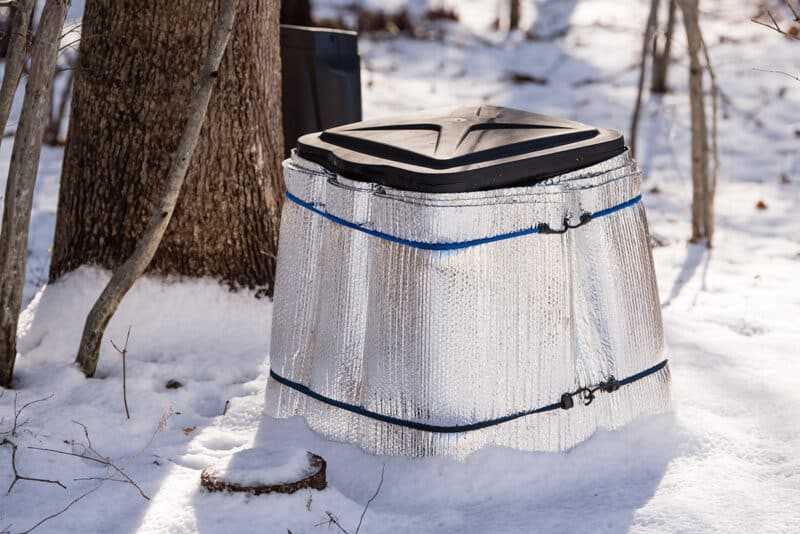
Recycled materials, such as old blankets or carpet pieces, can be repurposed as insulation for your compost heap. These materials are readily available and can provide effective insulation.
4. Bubble Wrap
Bubble wrap can also be used as a simple and cost-effective insulation material. Simply wrap it around your compost heap, ensuring that the bubbles face inward to provide insulation.
5. Insulation Blankets
Insulation blankets specifically designed for compost heaps are available in the market. These blankets are made from materials like recycled denim or polyester and provide excellent insulation while allowing airflow.
6. Foam Panels
Foam panels offer a more durable and long-lasting insulation solution for your compost heap. These panels can be cut to fit the size of your compost heap and provide excellent thermal insulation.
7. Reflective Materials
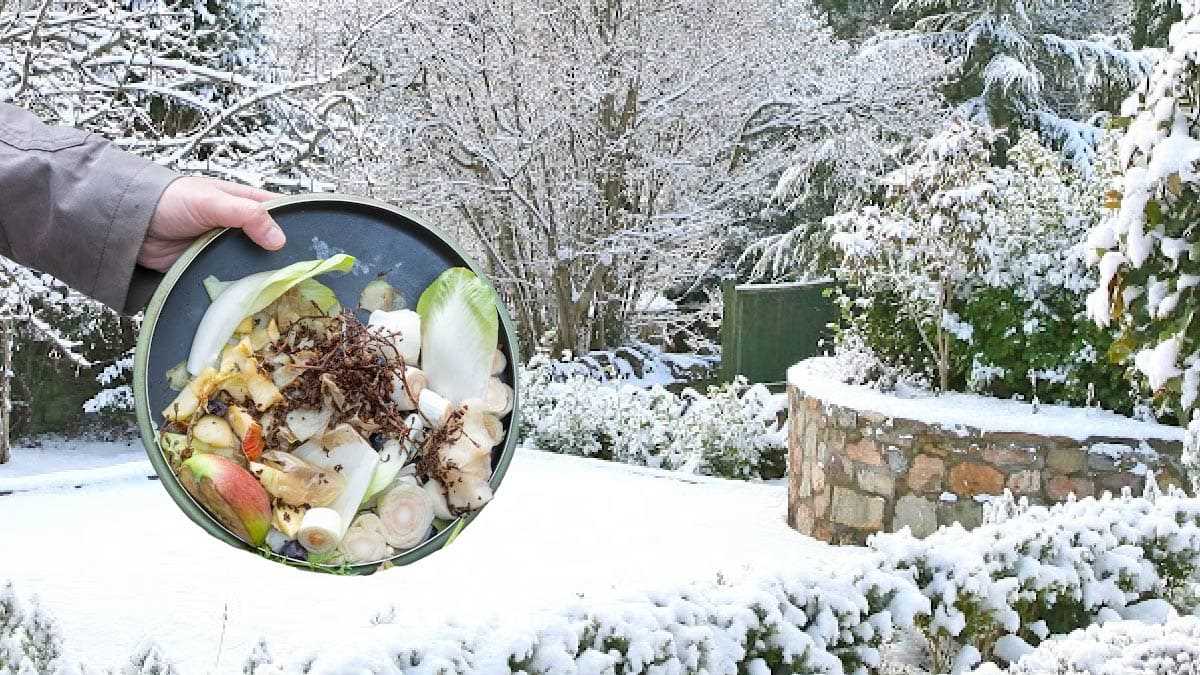
Reflective materials, such as foil or Mylar, can be used to cover the sides of your compost heap. These materials reflect the heat back into the compost, helping to maintain a warm environment.
8. Combination of Materials
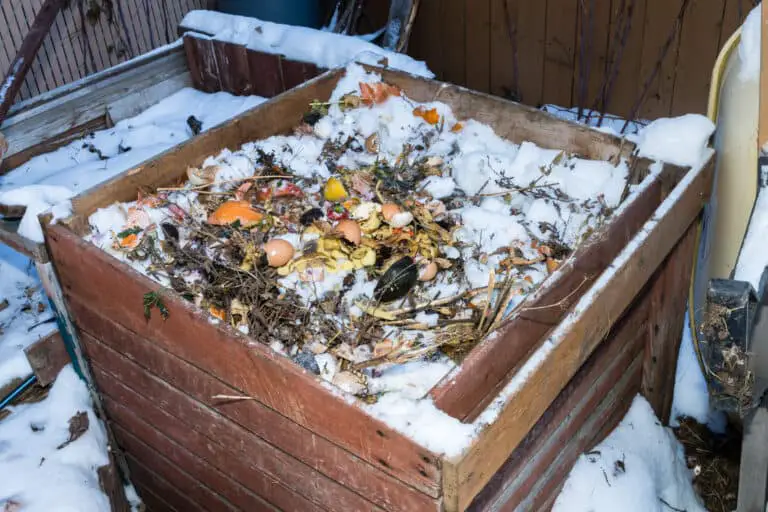
Using a combination of insulation materials can enhance the effectiveness of insulation for your compost heap. For example, you can cover the heap with a layer of straw and then wrap it with a recycled blanket for added insulation.
When choosing insulation materials, consider the climate in your area, availability of materials, and your specific needs. Experimentation may be necessary to find the most effective insulation option for your compost heap. Remember, the goal is to maintain a warm and active environment for the worms throughout the winter season.
How to Layer and Cover Your Compost Heap
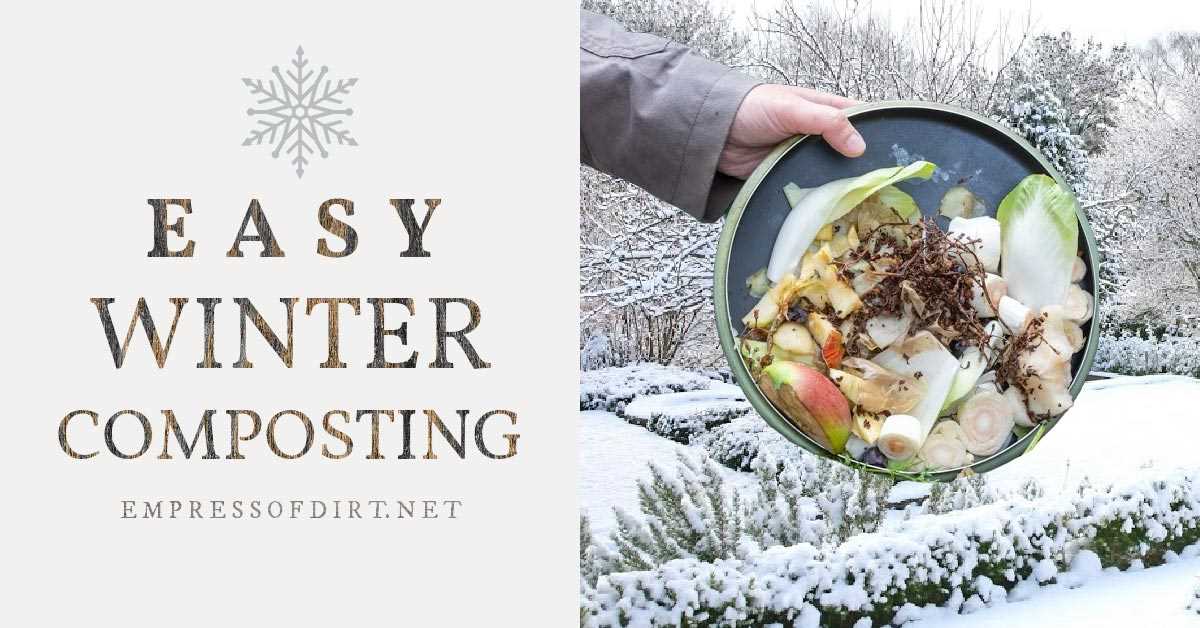
Layering and covering your compost heap is an important step in keeping the worms active and preventing freezing during the winter months. By following these steps, you can ensure that your compost heap stays warm and breaks down efficiently.
1. Start with a Base Layer
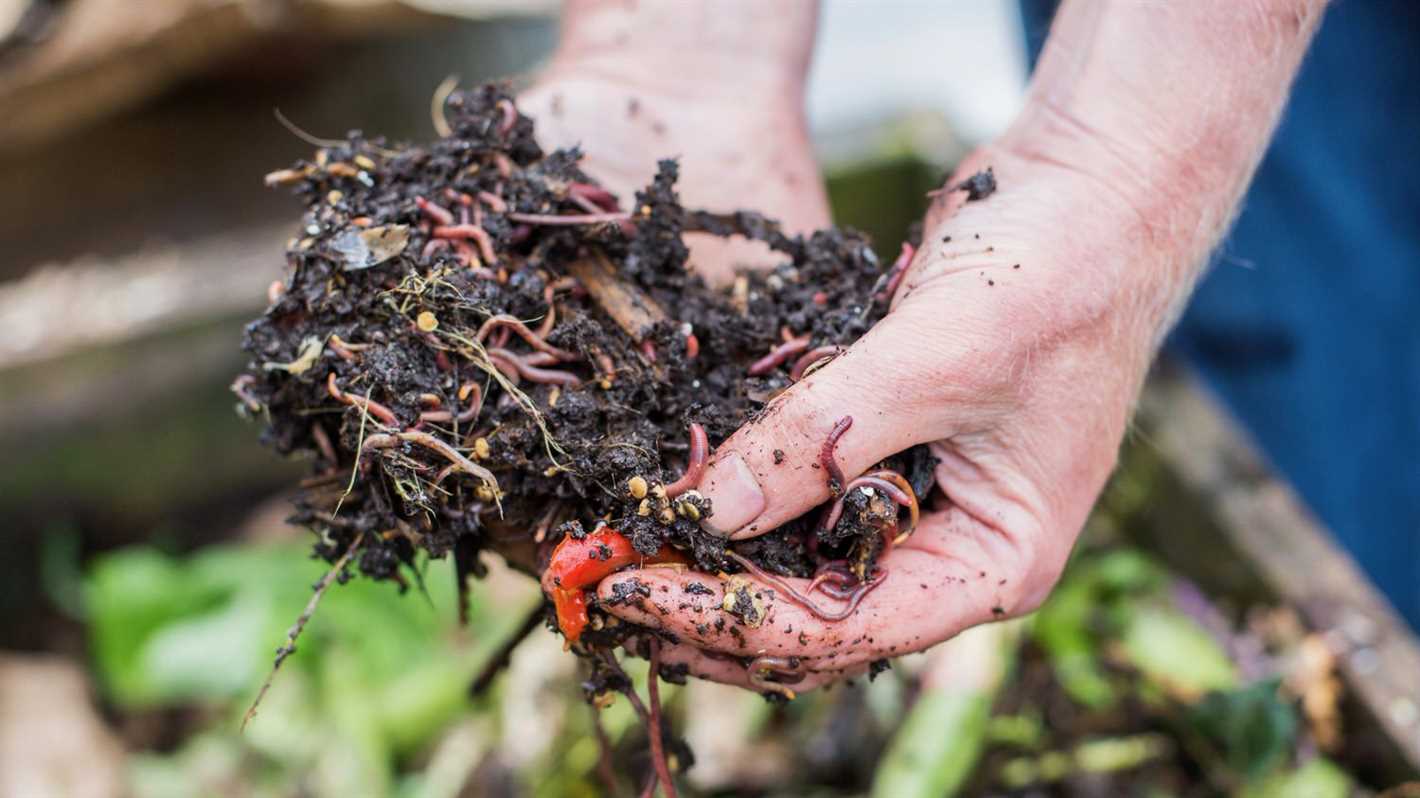
Begin by creating a base layer for your compost heap. This layer should consist of a mixture of brown materials, such as dried leaves or shredded cardboard, and green materials, such as kitchen scraps or fresh grass clippings. Aim for a ratio of about 3 parts brown material to 1 part green material.
2. Add Layers of Organic Matter
Continue to add layers of organic matter to your compost heap. Alternate between brown and green materials, making sure to mix them together to encourage decomposition. Some examples of brown materials include wood chips, straw, or shredded newspaper, while green materials can include fruit and vegetable scraps, coffee grounds, or plant trimmings.
3. Keep the Layers Moist
It’s important to keep the layers of your compost heap moist, but not too wet. Aim for a moisture level similar to that of a well-squeezed sponge. If the compost heap becomes too dry, water it lightly. If it becomes too wet, add more brown materials to help absorb the excess moisture.
4. Cover the Heap
Once you’ve added enough layers to your compost heap, it’s time to cover it. Use a layer of straw, leaves, or wood chips to cover the top of the heap. This cover will help insulate the compost and prevent heat loss during the colder months.
5. Monitor and Turn the Heap
Throughout the winter, make sure to monitor the moisture level and temperature of your compost heap. If it starts to dry out, add some water, and if it starts to freeze, consider adding more insulation. Additionally, remember to turn the heap every few weeks to help aerate it and speed up the decomposition process.
By layering and covering your compost heap, you can provide a warm and insulated environment for the worms to thrive and prevent freezing during the winter months. This will ensure that your compost breaks down efficiently and provides valuable nutrients for your garden in the spring.
Maintaining Proper Moisture Levels
One essential aspect of maintaining a healthy compost heap during the winter is to monitor and maintain proper moisture levels. Here are some tips to help you ensure your compost heap stays moist:
- Check the moisture regularly: It’s crucial to check the moisture level of your compost heap regularly, especially during the winter months when the cold weather can dry it out faster. Stick your hand into the compost pile to assess its moisture content. It should feel damp and easily clump together.
- Add water if necessary: If you find that your compost heap is too dry, you can add water to increase its moisture content. Use a watering can or hose to evenly distribute water over the compost pile. Be careful not to overwater, as excessive moisture can lead to a lack of oxygen and promote anaerobic decomposition.
- Keep a balance: It’s important to maintain a balance between moisture and aeration in the compost heap. Avoid letting the heap become too wet and soggy, as this can lead to the formation of compacted layers that restrict airflow. If the compost pile is too wet, consider adding dry materials, such as straw or shredded newspaper, to absorb excess moisture.
- Cover the compost heap: Using a cover or tarp can help protect the compost heap from excessive moisture caused by rain or snow. Ensure that the cover is securely fastened to prevent it from blowing away in strong winds.
- Turn the compost: Turning the compost heap regularly is not only beneficial for aeration but also helps distribute moisture evenly. As you turn the pile, moist layers from the center will be mixed with drier layers from the outside, maintaining a balanced moisture content throughout.
- Utilize natural moisture sources: Take advantage of natural moisture sources, such as melting snow or rain, to keep your compost heap adequately moist. Positioning your compost pile in an area where it can receive natural precipitation can contribute to maintaining proper moisture levels.
By following these tips and regularly checking the moisture level of your compost heap, you can ensure that your worms stay active and decomposition continues even during the winter months.
Monitoring and Troubleshooting Your Insulated Compost Heap
Monitoring
Monitoring your insulated compost heap is important to ensure that it is functioning effectively and producing good quality compost. Regular monitoring allows you to identify any issues or adjustments that need to be made to maintain optimal conditions.
- Check the temperature: Use a compost thermometer to monitor the temperature inside the compost heap. The ideal temperature range for composting is between 120°F (49°C) and 160°F (71°C). If the temperature drops below this range, you may need to add more insulation or adjust the materials in the heap.
- Check the moisture: The compost heap should be moist, but not waterlogged. Use a moisture meter or simply squeeze a handful of compost to check the moisture content. If it feels too dry, you can water it with a hose or sprinkle water on top. If it feels too wet, you can turn the heap to allow for better airflow and drainage.
- Check the oxygen levels: Oxygen is essential for the composting process, so it’s important to ensure good airflow. Use a pitchfork or shovel to turn the compost regularly, allowing oxygen to penetrate the material. You can also monitor the presence of earthworms, as their activity indicates a healthy compost heap.
Troubleshooting
If you encounter any issues with your insulated compost heap, there are several troubleshooting steps you can take to address the problem:
- Foul odor: If your compost heap has a foul odor, it may be an indication of anaerobic conditions or too much moisture. Turn the heap to improve aeration and drainage, and add dry materials like straw or shredded newspaper to help absorb excess moisture.
- Slow decomposition: If your compost heap is not decomposing efficiently, it may need more nitrogen-rich materials or carbon-rich materials. Adjust the ratio of green (nitrogen-rich) and brown (carbon-rich) materials by adding more of the appropriate type to restore balance.
- Pests or rodents: If you notice pests or rodents in your compost heap, it may be due to the presence of food scraps or other attractants. Avoid adding meat, dairy, or oily foods to your compost. Secure the heap with wire mesh or chicken wire to prevent animals from accessing it.
- Uneven moisture or temperature: If your compost heap has uneven moisture or temperature levels, it may be due to poor layering or inadequate insulation. Ensure that you layer your compost materials properly and add enough insulation to maintain consistent conditions throughout the heap.
| Issue | Solution |
|---|---|
| Foul odor | Improve aeration and drainage; add dry materials |
| Slow decomposition | Adjust the ratio of nitrogen-rich and carbon-rich materials |
| Pests or rodents | Avoid adding attractants and secure the heap |
| Uneven moisture or temperature | Improve layering and add more insulation |
Harvesting the Rich Compost in Spring
Springtime is the perfect season to harvest the rich compost that has been slowly decomposing throughout the winter months. Here are some steps to ensure a successful compost harvest:
- Prepare the area: Clear the area around your compost heap and make sure it is easily accessible. This will make it easier to remove the compost once it’s ready.
- Check the moisture: Before harvesting, check the moisture level of the compost. It should be moist, but not too wet. If it’s too dry, you can sprinkle some water to moisten it.
- Use a pitchfork or shovel: Use a pitchfork or shovel to carefully turn the compost heap. This will help mix the decomposed material and aerate the pile, ensuring a more even decomposition.
- Separate the finished compost: As you turn the compost, separate the finished compost from the unfinished material. The finished compost should have a dark, crumbly texture and an earthy smell. Set it aside in a separate pile or container.
- Sieve the compost: To remove any large particles or chunks, you can sieve the compost. Use a mesh screen or a compost sieve to sift through the material, collecting the fine, crumbly compost.
- Store or use the compost: Once you have collected the rich, finished compost, you can store it in a dry, covered area or use it immediately in your garden. The compost will provide essential nutrients to your plants and help improve the soil structure.
By harvesting the rich compost in spring, you can take advantage of its nutrient-rich properties and use it to enhance the health and productivity of your garden.
“Question-Answer”
How can I prevent my compost heap from freezing in winter?
To prevent your compost heap from freezing in winter, you can insulate it by adding a layer of straw, hay, or leaves on top. This will help to trap heat and keep the worms active. You can also consider using a compost bin with insulated sides, or covering the heap with a tarp to protect it from the cold.
What are some materials I can use to insulate my compost heap?
There are several materials you can use to insulate your compost heap. Straw, hay, and leaves are commonly used as they provide good insulation. Other materials you can consider include wood chips, shredded newspaper, or even old blankets or carpet scraps.
Do I need to add a lot of insulation to my compost heap?
The amount of insulation you need to add to your compost heap will depend on the severity of the winter temperatures in your area. Generally, adding a layer of insulation that is at least several inches thick should be sufficient to protect the compost from freezing. However, if you live in an extremely cold climate, you may want to consider adding a thicker layer or using a more insulating material.
Can I still add kitchen scraps to my compost heap in winter?
Yes, you can still add kitchen scraps to your compost heap in winter. However, it is important to bury the scraps deep within the pile to prevent them from freezing. You can also consider using a compost bin with a lid to help retain heat and protect the kitchen scraps from freezing.
Will insulating my compost heap help to keep the worms active?
Yes, insulating your compost heap will help to keep the worms active. Worms are sensitive to extreme temperatures, and insulating the heap will provide them with a warmer environment. This will allow them to continue breaking down the organic materials and speeding up the composting process even in winter.
Can I use a tarp to cover my compost heap for insulation?
Yes, you can use a tarp to cover your compost heap for insulation. A tarp can help to trap heat and protect the heap from the cold winter temperatures. However, it is important to ensure that the tarp is securely fastened to prevent it from blowing away in strong winds. Additionally, you should periodically lift the tarp to check the moisture levels and make sure the compost is not becoming too wet.







